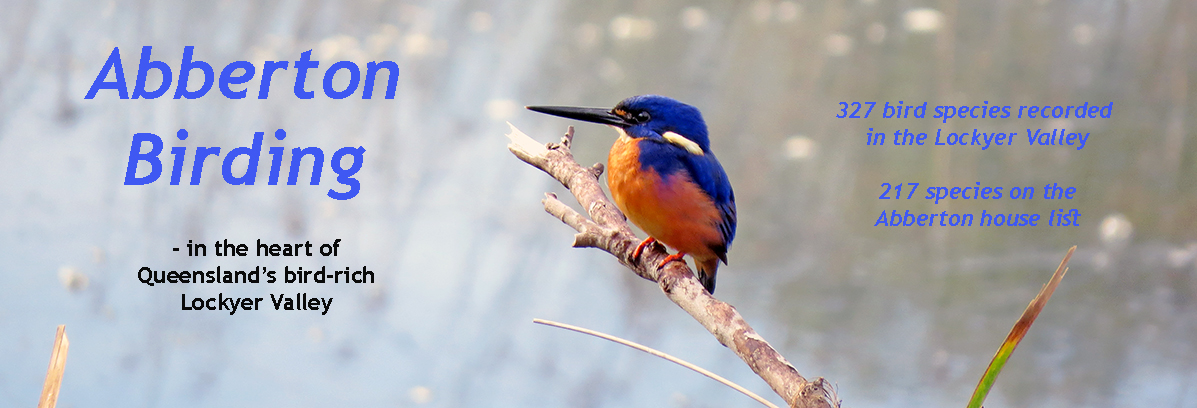|
January - March, 2014
Platypus remain regular. We never go looking for them. We're so privileged to have these ancient mammals still here, living as they have always done, that I feel it would be reckless to disturb them with lights at night when they're most active - so we're more than content with the daytime sightings we get. An overcast afternoon is a time we often see them, but then again so is early morning, and I've even seen them feeding at noon!

A daytime Platypus
This one was feeding in the middle of the creek around 11.30am. The photo was taken from the house, and a little distant, so I'll include a tightly cropped (if blurry) close-up below showing inter alia the distinctive pale patch close to the eye.

Platypus reprise
I'll take this opportunity to include again some better platypus photos that I took here in 2007.
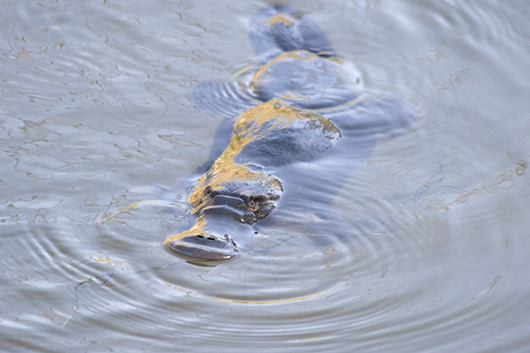

This platypus was typically busy nosing around the creek margins, diving every once in a while to feed on the bottom, then reappearing a little way off to float on the surface whie eating the catch. Platypus can be fairly predictable in terms of their progress along the margin, so a stealthy approach can allow one to get ahead and wait for its approach - freezing while he's on the surface, and taking a few steps closer whenever he dives.
It doesn't always work of course, the platypus can often re-emerge a long way off in the other direction, or over by the opposite bank, or not at all! However, this day was one to remember with lengthy close views and heaps of photographs.
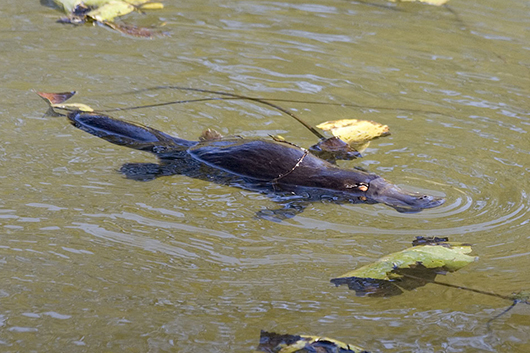
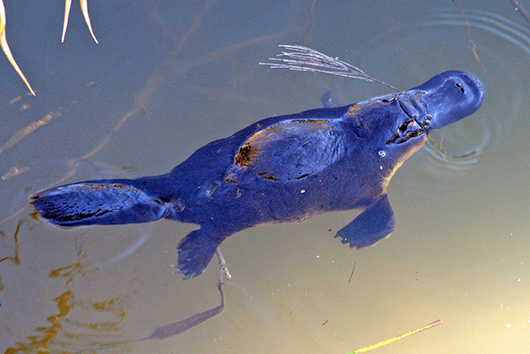

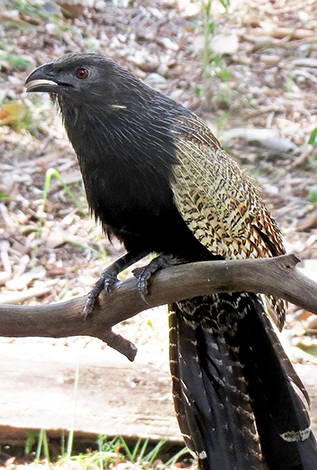


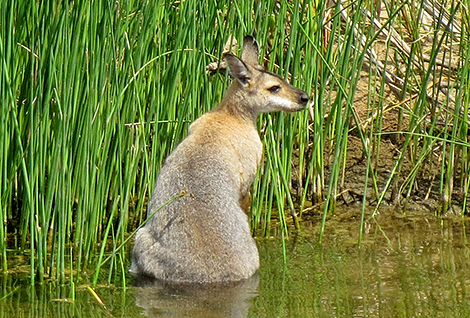
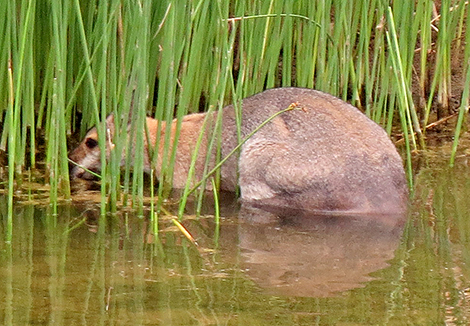
Red-necked Wallaby at the creek on a hot day
April - May, 2014
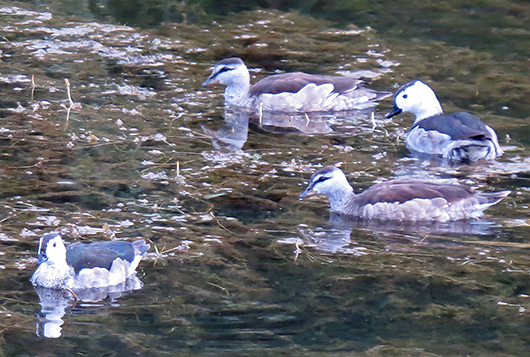
Cotton Pygmy-Geese
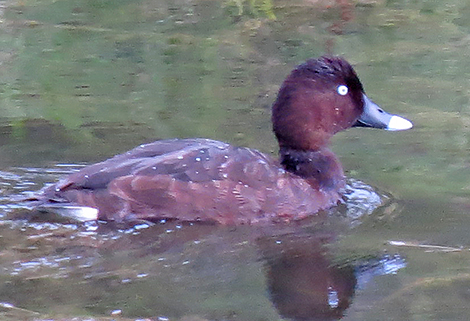
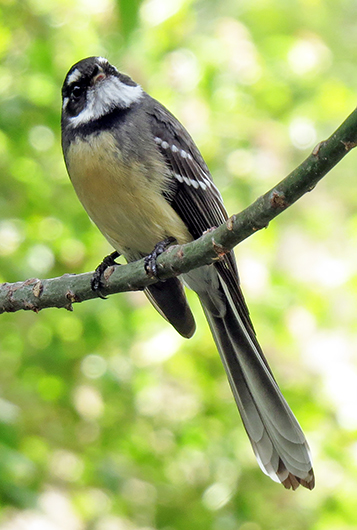


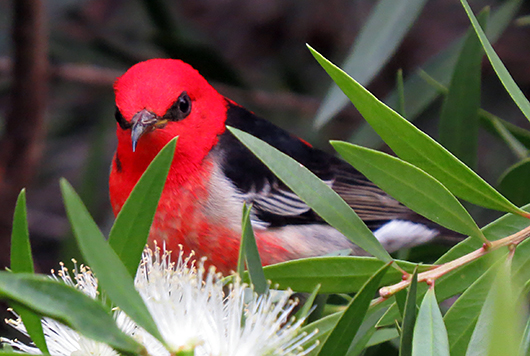

Scarlet Honeyeaters
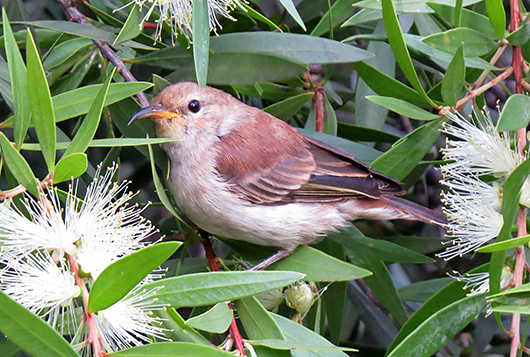
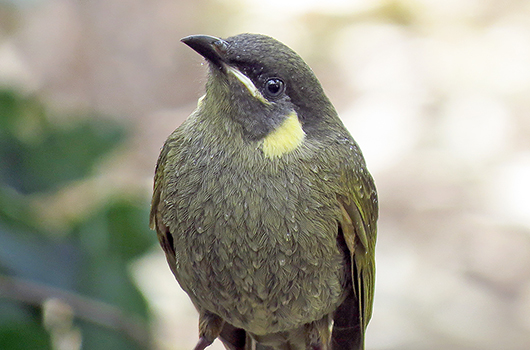
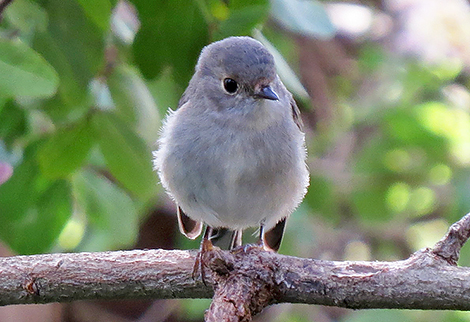



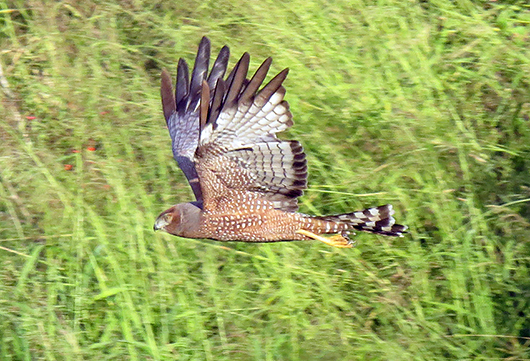
Spotted Harrier

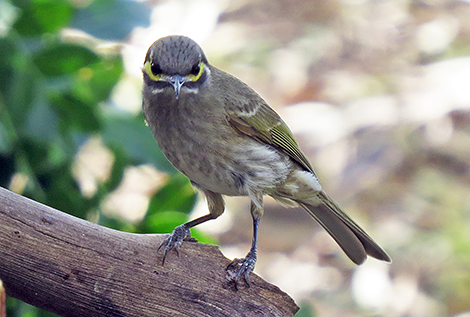
Yellow-faced Honeyeater
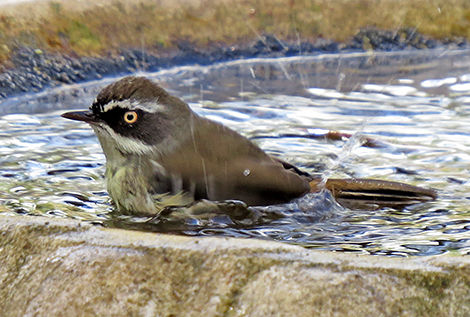
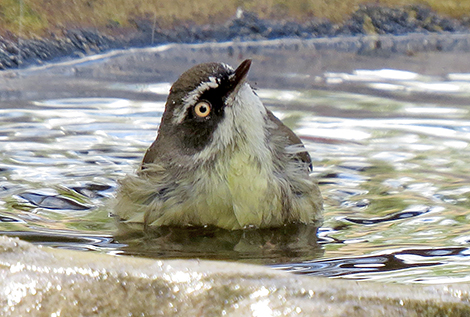
White-browed Scrubwren
July, 2014 - Plumheads and others
We've been very focused on planting trees, as well as building a new deck on the north side of the house to catch the winter sun. We'll
continue sit out on the south side in the summer of course, overlooking the creek and away from the summer sun, but the new "winter deck"
overlooks a couple of birdbaths that are pretty busy all year round, and it's our current favourite.
Here are some recent pics of some birds at the birdbaths - regulars like Striated Pardalote and Variegated
Fairywren, and the less frequent Plumheaded Finches. Though when the Plumheads turn up they usually do so in numbers, about a dozen or so
competing for space in the bath on this week's visit.
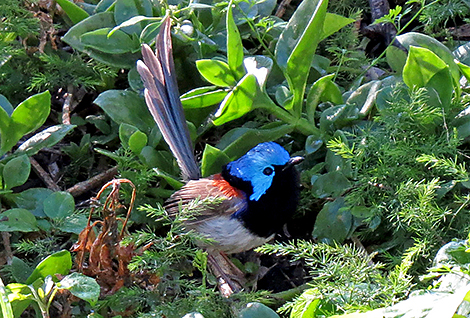



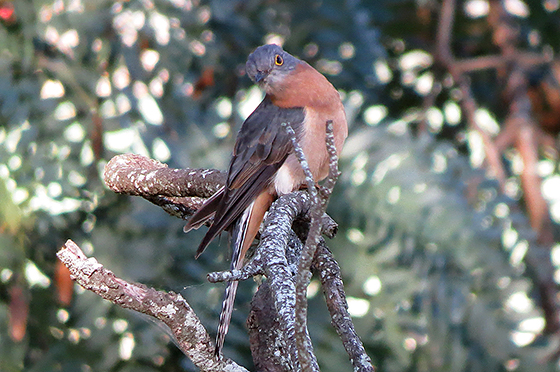
A Fan-tailed Cuckoo who has been here for a while now

Chestnut-breasted Mannikin
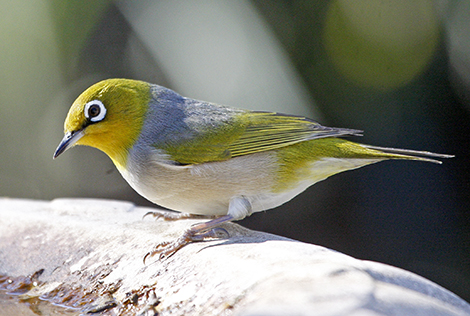



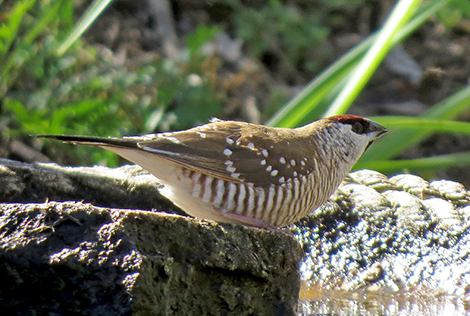
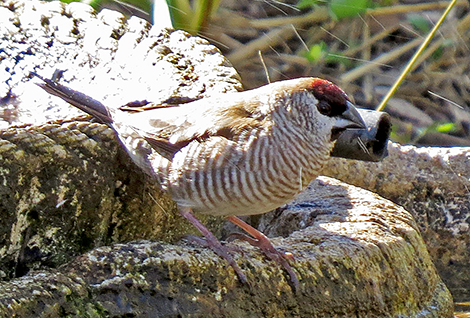
Plum-headed Finches
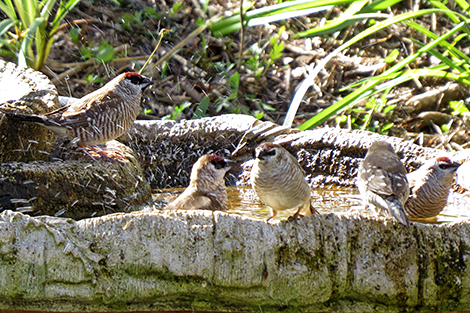
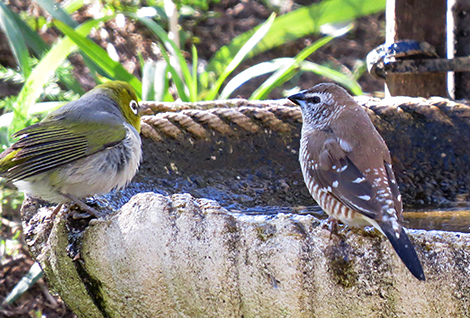
A beautiful male Eastern Spinebill is around the gardens close to the
house this-morning, but so far he has declined to be photographed.
STOP PRESS - Got him! But only just.
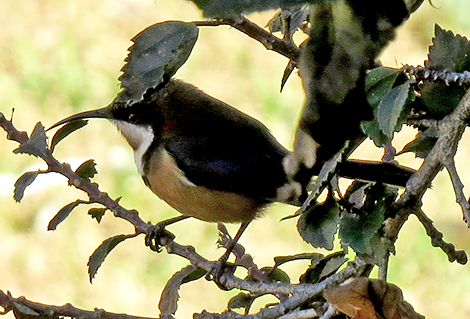

August, 2014 - Olive-backed Oriole
It's just an Olive-backed Oriole at the birdbath next to the new deck, and the photo includes bits of hoses and sticks and such, but what a lovely bird!
Oriolus sagittatus. They breed here every year, and as winter continues to wane it looks like they're already thinking about doing so again.
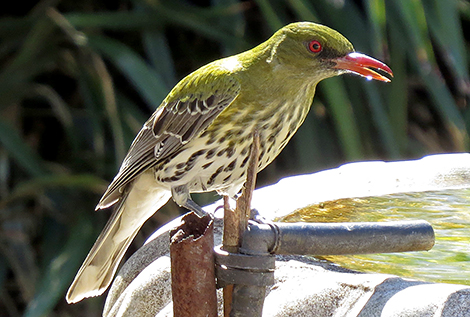

Olive-backed Oriole
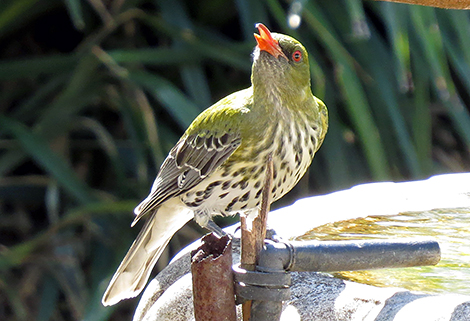
September, 2014 - A couple of ducks
Both species seen locally in the last few days, one at the southern edge
of its range, the other pretty well at its northern-eastern limit.
This is the male of a pair of Cotton Pygmy-geese seen from the verandah
this-afternoon. Cotton Pygmy-geese are usually to be found somewhere in
the valley, favouring water-lily strewn lagoons, and have been turning
up at Abberton more frequently over the last couple of years.


Cotton Pygmy-goose
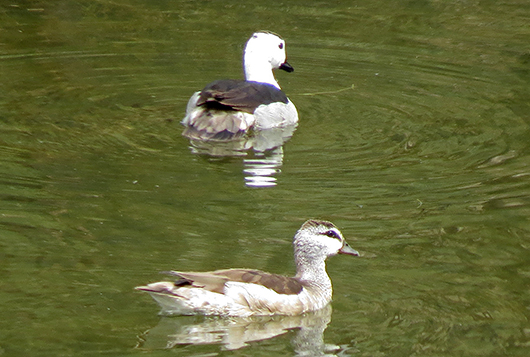
Cotton Pygmy-goose - male and female
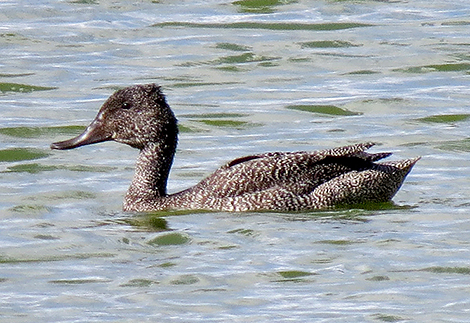
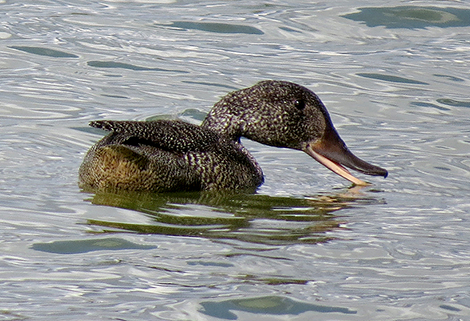
Freckled Duck
The Freckled Duck however is at best an intermittent visitor to our
region, with intervals of several years often passing between visits. I
assume this bird is a non-breeding male on account of the lingering
reddish hue at the base of his bill.
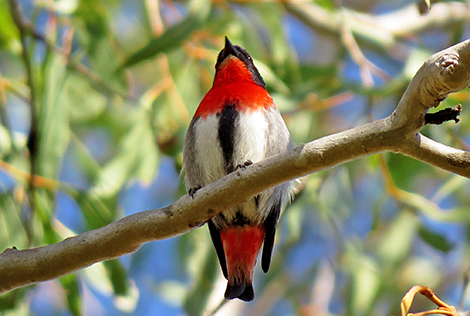
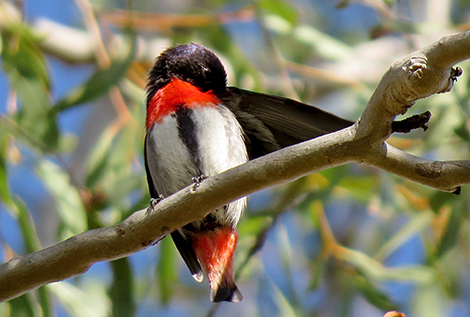
Mistletoebird
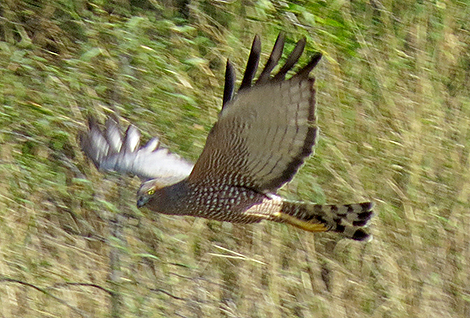
Spotted Harrier

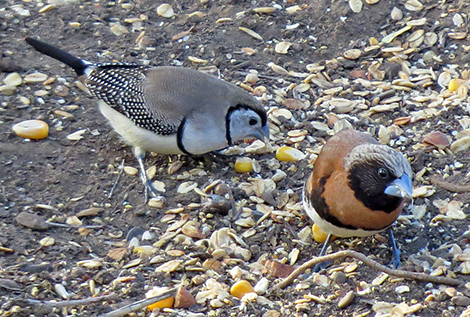


October, 2014 - Spring!
I guess I say the same thing around this time every year - but it's such
a joy to step out on the verandah and into a Queensland spring morning!
The whole garden is bursting with sights and sounds of spring, but more
than that, it feels as though the season itself is wrapping itself
around you in a warm embrace. I'm sure I write something
similar at the end of September or early October every year - but I
can't help it, it's simply how it is!
I'll try to restrain myself, and just report that Channel-billed
Cuckoos, Koels, Sacred Kingfishers, Dollarbirds are all back. Rainbow
Bee-eaters never went away, but they are particularly exuberant just
now. Many birds are either courting or nesting, including a pair of Grey
Shrike Thrushes who have hatched two young in a plant pot high on a wall
under the eaves, and Tawny Frogmouths who have returned to their regular
nest site in a big eucalypt near the back gate.

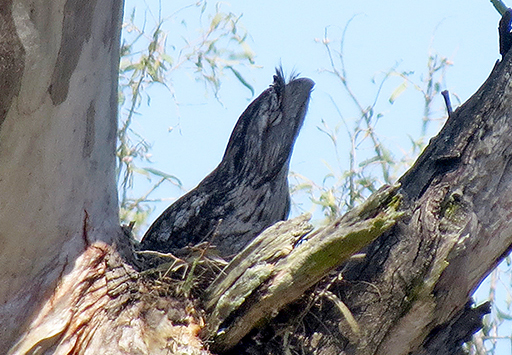
Tawny Frogmouth on the nest
A couple of handheld shots of a high nest location, showing a Tawny Frogmouth sitting in the
first image, and in the second image (having spotted me) pretending to be just a part of the tree.

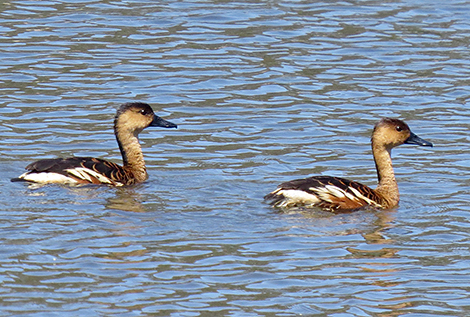
Royal Spoonbill, Plumed Whistling Ducks, Magpie Geese - and on the right, two Wandering Whistling Ducks

Red-kneed Dotterel
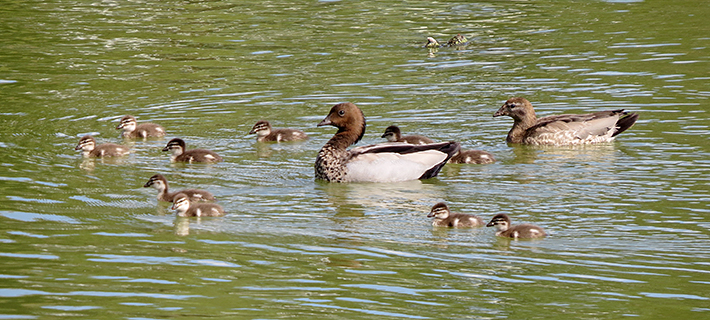
Australian Wood Duck family
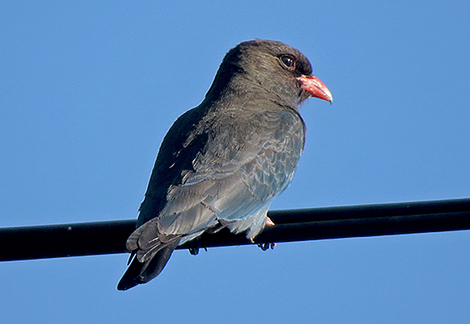
Dollarbird
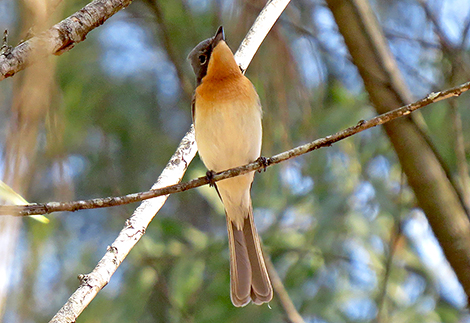



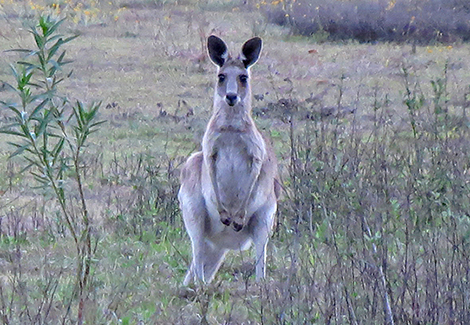
Eastern Grey Kangaroo
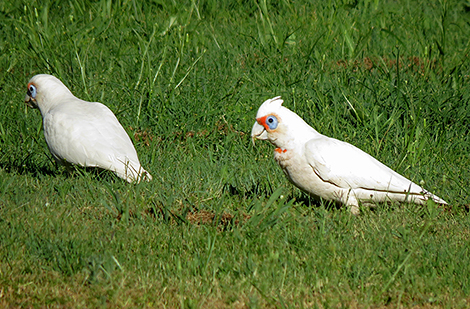

Long-billed Corellas
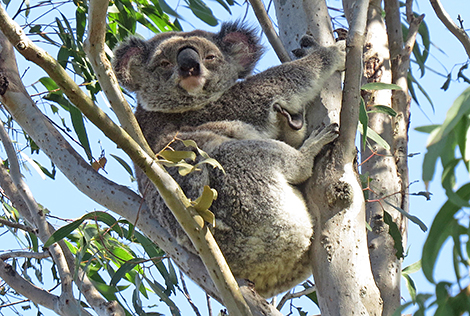

Two different Koalas (look at their noses) in the garden - taken a few days apart
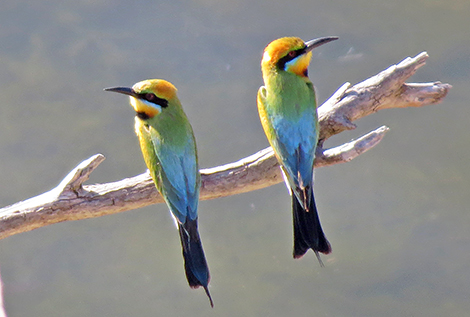
Rainbow Bee-eaters


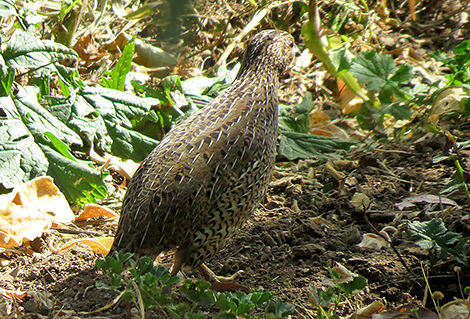

Brown Quail
November, 2014
The Tawny Frogmouths have hatched two beautiful chicks!
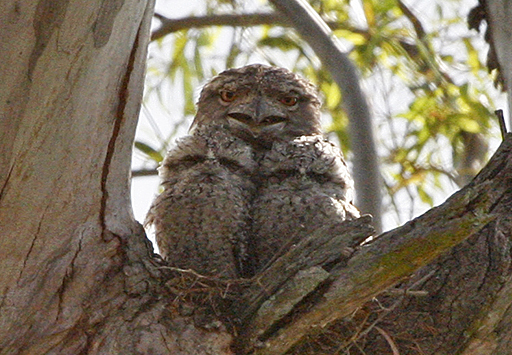
18th November
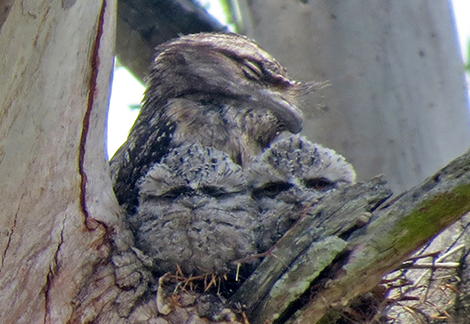




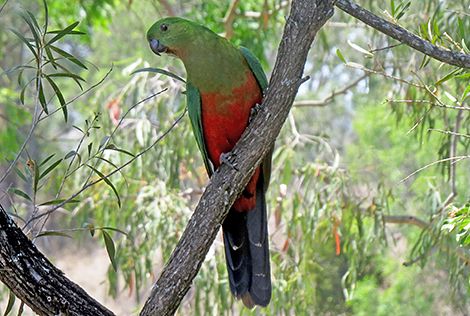
Australian King Parrot - male and female
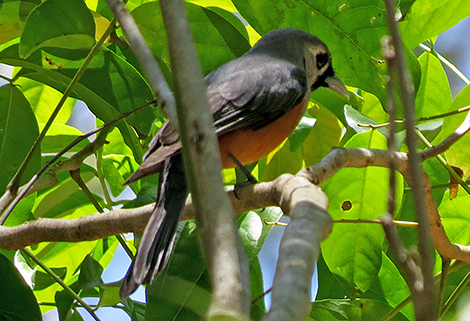
Black-faced Monarch
March, 2015 - Catching Kingfishers
Last month I wrote this to a birding friend:
"Azure Kingfisher
zipping up and down the creek a lot over the last few days.
I shall
erect a fallen branch as a tempting creek overhang from which he
may fish in full view of the verandah.
I did the same thing about ten years ago and it snared an Azure
on the first day!"
Next day, I duly 'planted' some dead limbs in a suitable location
on the creekbank, and began the wait...
Over the next week the new vantage point was utilised by Willie
Wagtails, Red-backed Fairywrens, Tawny Grassbirds,
a Spangled Drongo, Pheasant Coucal quite a lot of birds - but no
Kingfishers.
Then a Sacred Kingfisher found it, and the new dead tree became,
and remains, a regular outlook
from which it daily surveys the creekside vegetation for prey.
But, though Azure Kingfishers continued to zip along the creek,
it took another month or so, until yesterday afternoon
- when Bingo! I stepped out on to the verandah to find an Azure
Kingfisher doing exactly what I had hoped
it would be doing - exactly where I hoped it would be doing it!

Azure Kingfisher
A distant rainy photo as a starter, with the hope of much more to
come.
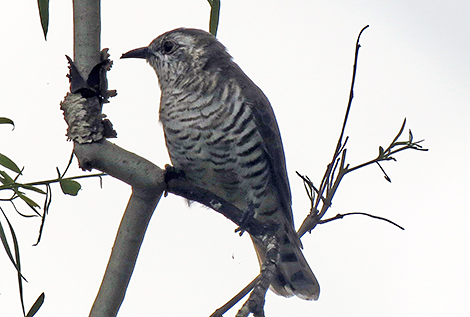

Little Bronze Cuckoos in the garden - probably different individuals
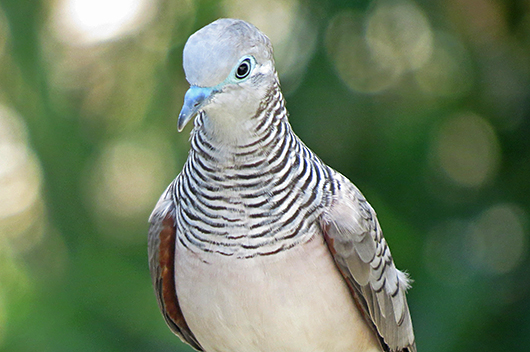
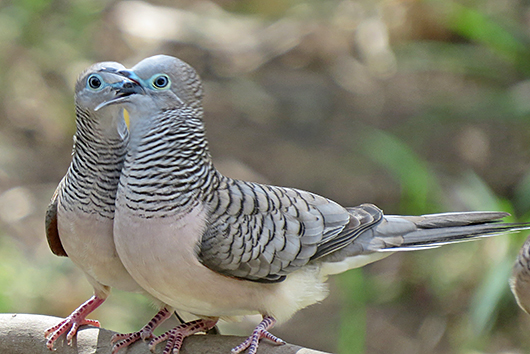
Peaceful Doves

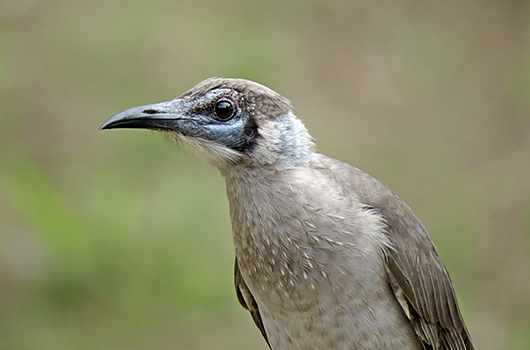
Little Friarbird
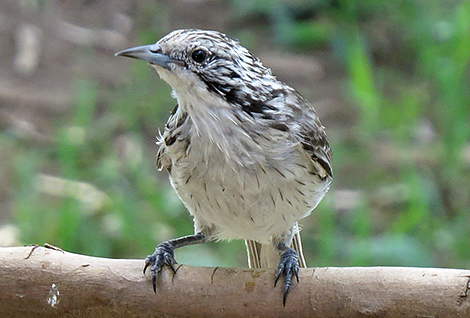
Striped Honeyeater
March, 2015 - In the garden
At end of February, we noticed that a pair of Black Swans had begun to lay down
the base of a nest in a patch of sedge right in front of the
house. Five days later, half the sedge patch had gone, the nest
was in place and the first egg laid!

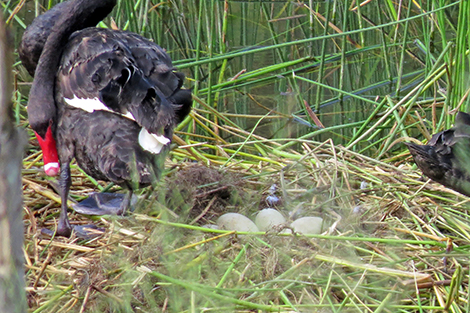
Black Swans at nest
We've been photographing them almost daily since and can vouch for at least 4 eggs
in the nest, which has continued to be added to in width and
height throughout. Full-time incubation was under way by 6th
March. Male and female are sharing incubation duties, though
the fairly ritualised changeovers of the early days have become
much more casual of late - allowing the above long-distance shot
of the nest with eggs clearly on show.
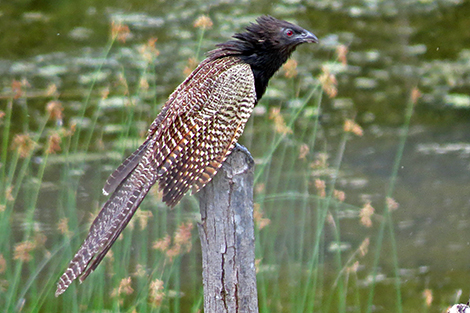
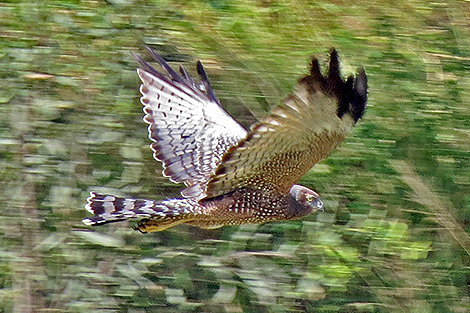



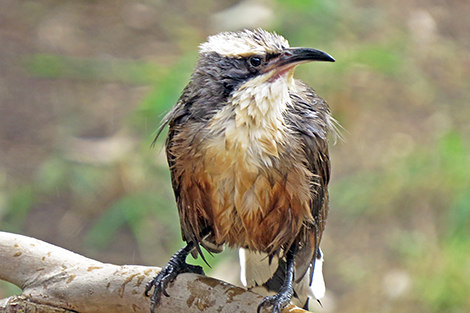


The sodden Grey-crowned Babbler was photographed mid-ablution at
the bird-bath outside my office window. Others pics from the verandahs.
It's been a good week here with Speckled Warbler, Plum-headed Finch,
Red-tailed Black Cockatoos, Azure Kingfisher and
Ground Cuckoo-shrikes in addition to our regulars. I wish I could
have photographed them all!
April, 2015 - Autumn




Autumn has delivered our first Rose Robin of the year, along with an influx of
Grey Fantails and an upsurge of both Rufous and Golden Whistlers
around the garden. Plum-headed Finches have become regular of
late, in their transient way, so five finch spp here most days just now.
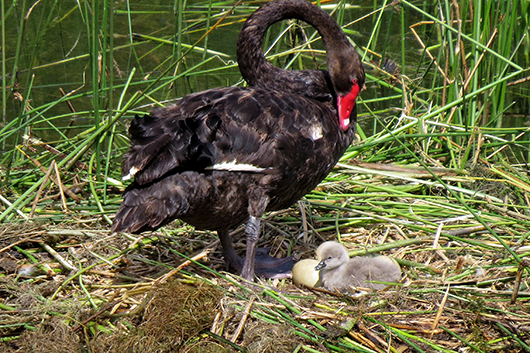
Our nesting swans laid four eggs in their nest, however only one hatched despite non-stop daily incubation.
But they did produce this lovely cygnet on which they jointly lavish all their attention.
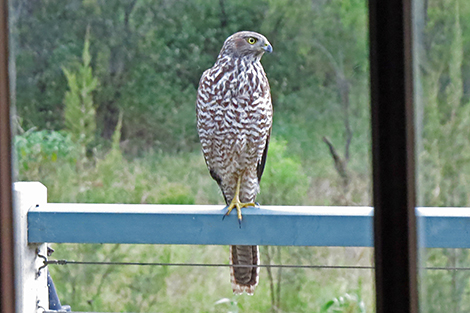



Plenty of raptors around this month, among which Little Eagle,
family groups of Pacific Bazas, and a Brown Goshawk who has taken
to turning up on the verandah rails.
Ten raptor spp here so far
during April - without a Nankeen Kestrel! Speckled Warblers are about too. A lovely time of year.
A mix of recent pics below, including a Grey Teal close alongside
a Pink-eared Duck (this one not at our place).
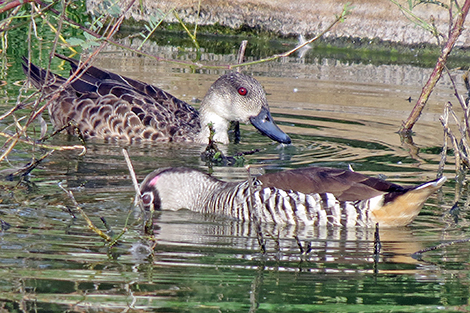
Grey Teal and Pink-eared Duck
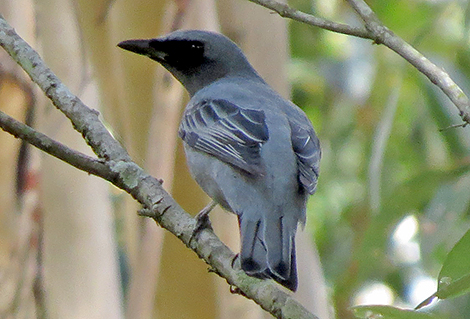
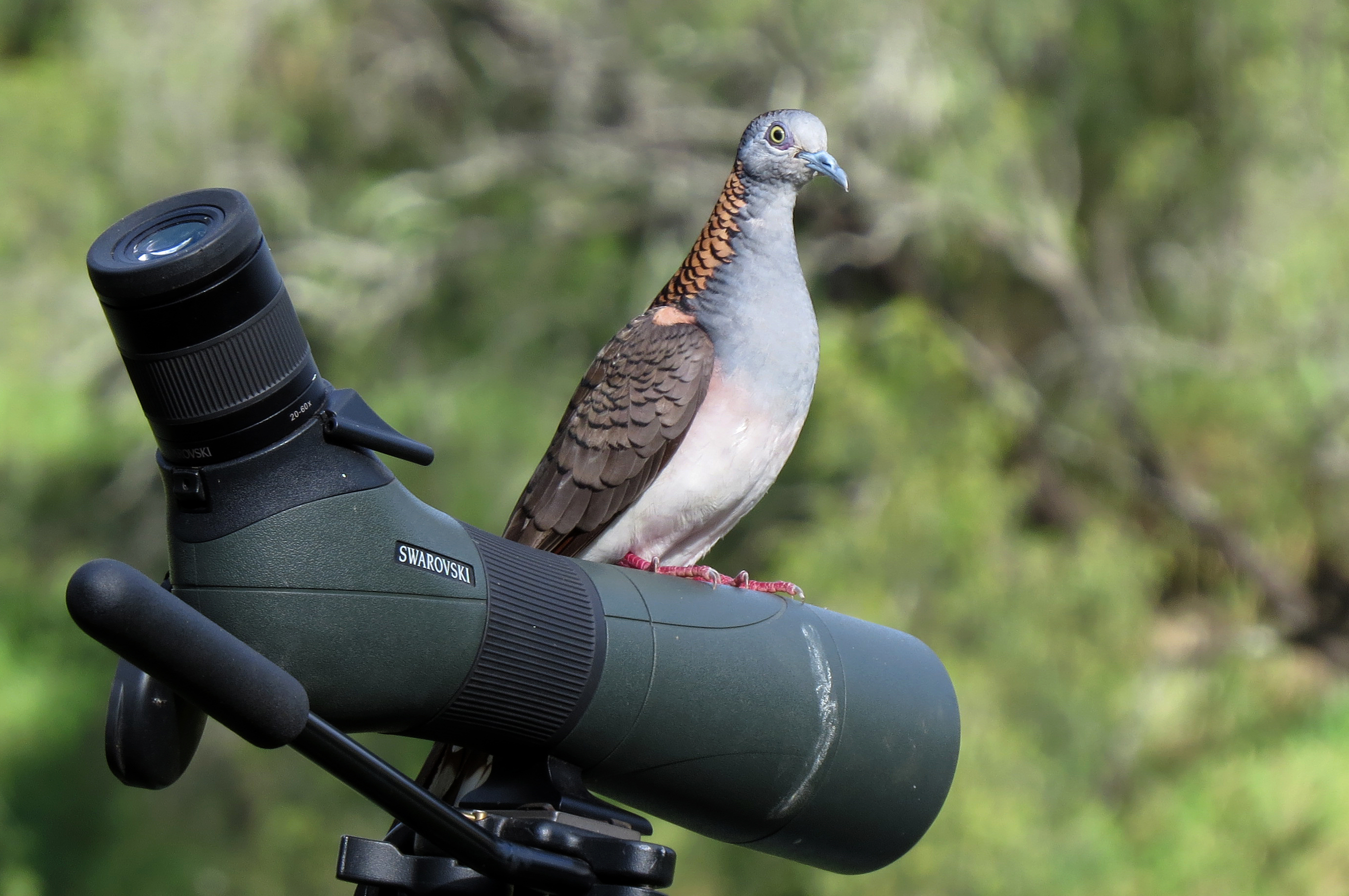






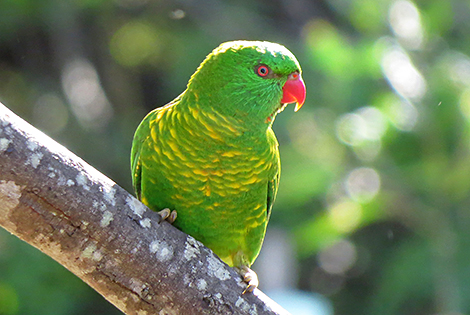
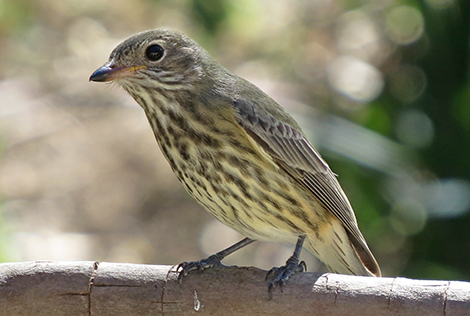




Royal and Yellow-billed Spoonbills
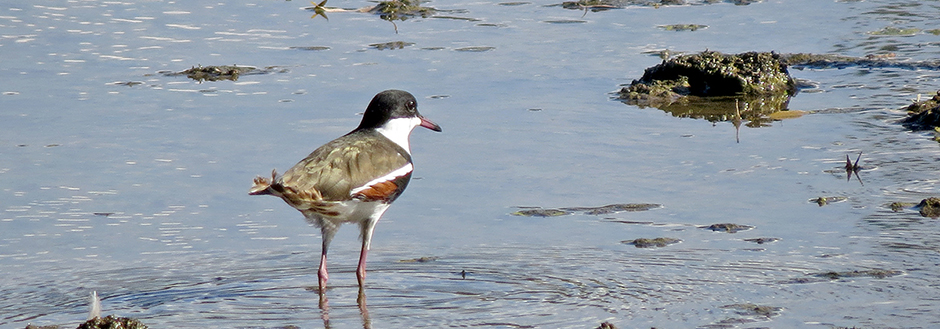
Red-kneed Dotterel above, and a good size comparison below, alongside a Black-fronted Dotterel

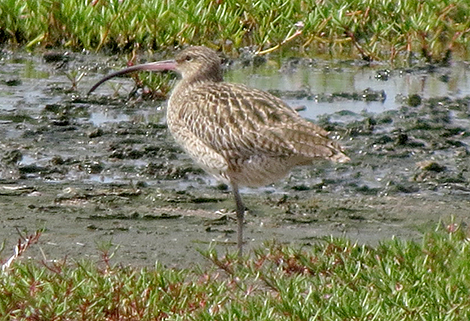
Eastern Curlew - on a strand close to Brisbane Airport
May, 2015 - Robins and Kingfishers
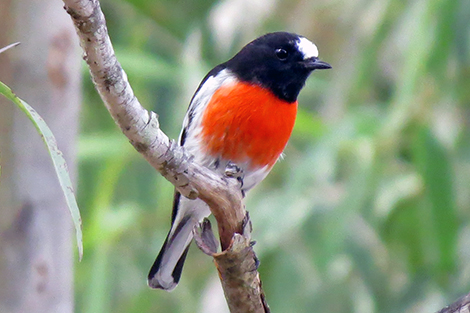
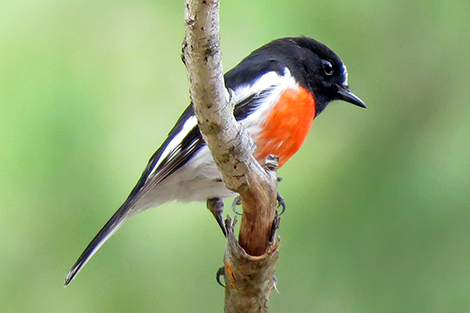
Scarlet Robin
A birding friend has been enjoying a visit from a male Scarlet Robin on her property
over the last few days. Scarlet Robins live in the south-east and
south-west corners of Australia and just squeeze into Queensland a
little way up from the NSW border, but it's only the occasional bird
that makes it here to the Lockyer Valley - usually in winter and at
intervals of several years.
So, a big thank-you to Alissa for sharing her excitement with me and
inviting me to pop over to take some photos.
We found the robin feasting away in a wooded glade, not at all bothered
about our presence during the whole hour or so that we were watching
him. Photos herewith - what a beauty!
The previous day, at home, I spotted an Azure Kingfisher fishing from
a snag in front of the house, one we had set there to encourage just
this activity. I took a couple of photos from the verandah, a bit
distant - what I think of as insurance shots - then headed down towards
the creek, stopping to increase my insurance every few metres. This
is one of the great advantages that comes with digital photography,
I would been much too conscious of the cost of each press of the shutter
when we were using film. So, closer and closer clicking away as I
went, and despite the kingfisher diving after prey every so often,it
came back to the same spot every time.
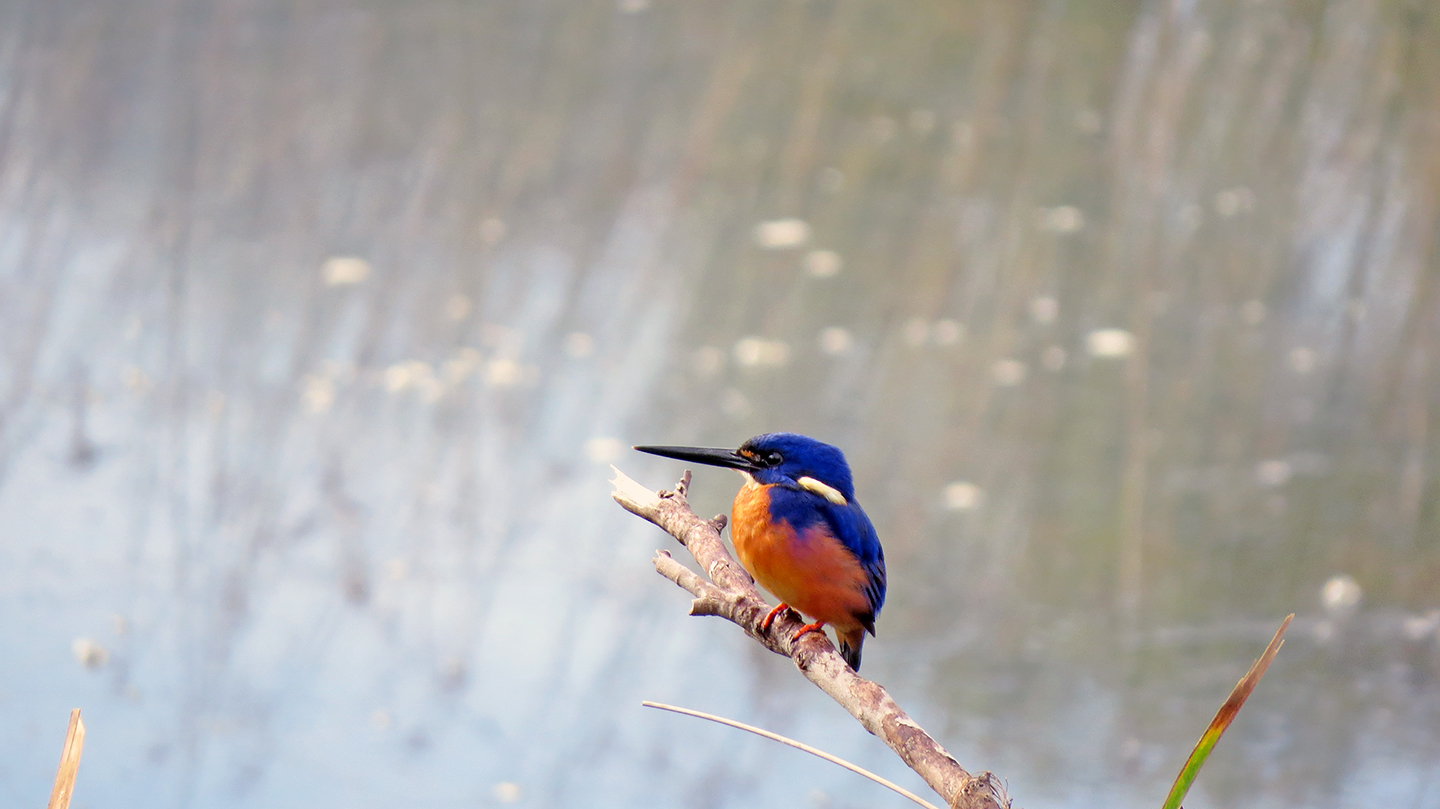
Azure Kingfisher
In the event, the Azure Kingfisher proved to be surprisingly tolerant, and I think
I might have some of my best kingfisher snaps to date.
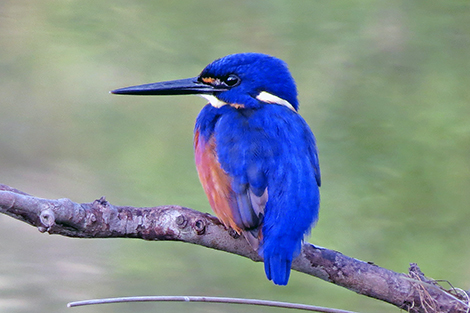
May, 2015 - More from a very pleasant time of year

Plum-headed Finch
A small party of Plum-headed Finches has been coming down to the bird baths for
the last few days, and also spending some time feeding on grasses.
They also feed a lot along the driveway right next to our front
step - theoretically, it's a bitumen/gravel driveway, but I do seem
to mow it every so often so I guess the photo tells the truth.
Plenty of raptors about of late. Grey Goshawk here today with crows
in noisy pursuit, Aussie Goshawk and Whistling and Black Kites every
day, White-bellied Sea-eagles are regular, and an immaculate Collared
Sparrowhawk was flitting around the garden from tree to tree on
Tuesday, merging each time into a new hiding place to await an opportunity
to launch his next pursuit.
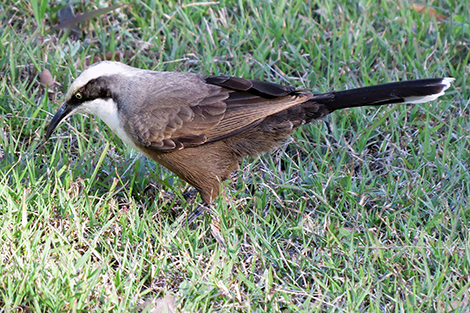
Grey-crowned Babbler
Grey-crowned Babblers are also around in chatty family groups. They allow me to
get quite close,
so much so that I wasn't able to crop this photo even a bit.
May, 2015 - Bathing in the afternoon
I mentioned some time back that I was thinking of adding a new deck
on the northern side of the house, alongside a birdbath.
As opposed to putting a birdbath alongside a deck.
After all, when you've got an established birdbath that is working
well for the local community, you don't want to let 'redevelopment'
sweep it away and relocate it in the second or third-best place!
And I'm happy to report that the new deck is working well for us,
while the birdbath is as busy as ever throughout most of the day,
and with a morning and afternoon rush-hour.

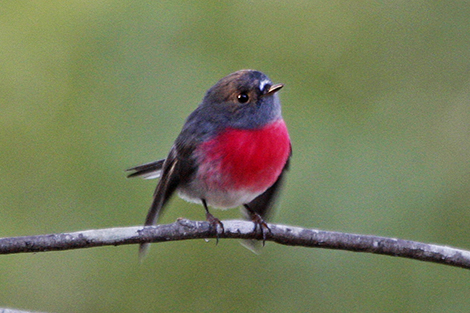
Rose Robin
I sat out on the deck for a while yesterday afternoon and snapped some of the late
drop-ins, including a male Rose Robin showing his natty rusty-coloured
ankle-socks in one photo and typical droopy-wing pose in another.

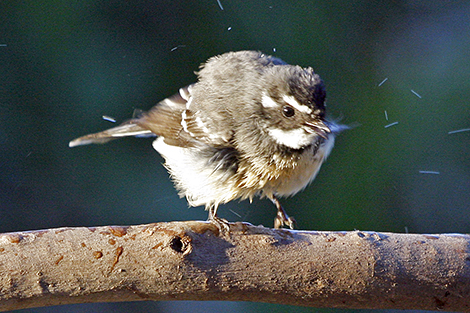


May, 2015 - Next day!

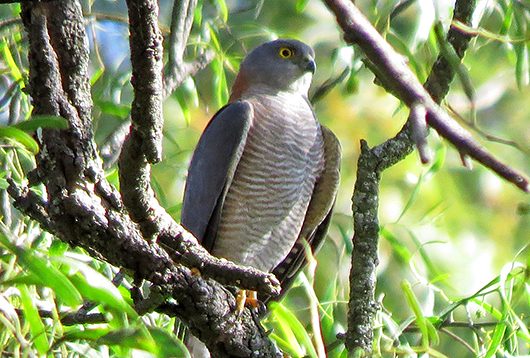
Collared Sparrowhawk
This-morning, while I was on Kingfisher-watch, a Collared Sparrowhawk dropped from a tree across the creek and with just a couple of wing-beats swept through a low parabola across the creek and up into a high eucalypt in our garden. I managed to find a keyhole in the network of intervening foliage to get a couple of snaps.
|
|
June, 2015 - First month of Winter
We've just passed our Winter Solstice, but it remains more autumnal than wintry
so far.
Plenty of raptors passing through - not in the sense of migrating
though, just passing through the garden or along the creek in their
daily search for sustenance. A pair of Square-tailed Kites were cruising
the tree-tops just along the road the other day,White-bellied Sea-eagles
are daily along the creek, as are a pair(?) of Whistling Kites who
seem to be spending a lot of time together in our biggest creek-side
eucalyptus.
We shall see if anything results from that.
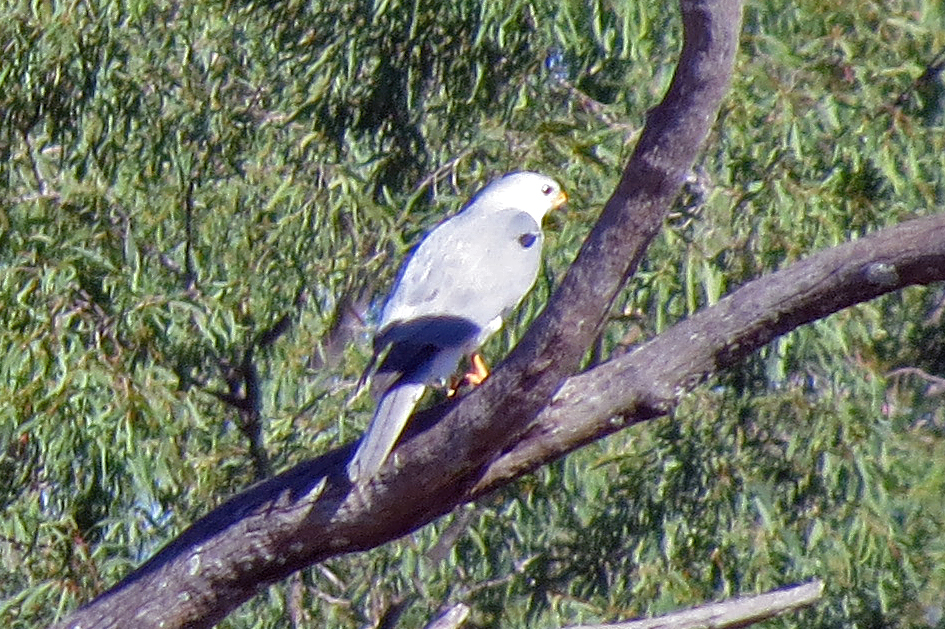
Grey Goshawk
Our regular accipiters were supplemented briefly last week by a Grey
Goshawk, which paused for a while, admidst a flurry of complaint,
in a big dead tree across the creek a little upstream from the house.
This photo taken from the verandah is a bit distant, but it was the
only chance he gave me.
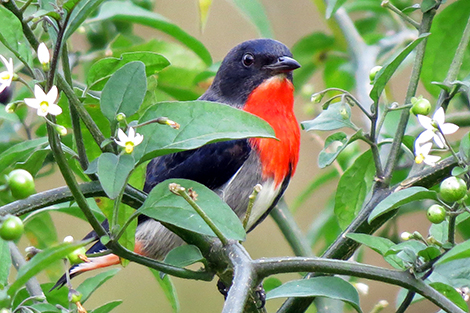
Male Mistletoebird
Meanwhile, back at ground level, Black Nightshade is fruiting everywhere.
It's a weed which I decline to pull out because its ripe berries are
irresistible delicacies for Mistletoebirds among others. (Evidence
above)
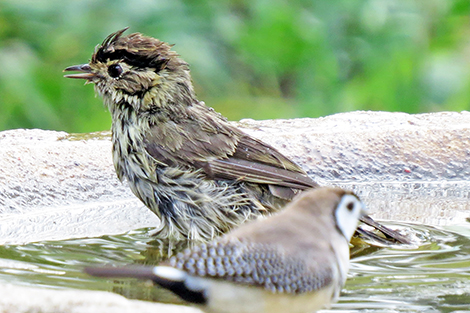
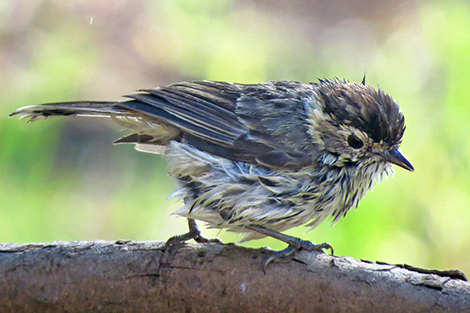
Speckled Warbler (and Double-barred Finch)
Also, a couple of photos of a male Speckled Warbler bathing just outside my window.
They have been long-established here, and have bred here in the
past. We've seen as many as four birds around this year (two pairs?)
and just now a male and female are feeding around the place along
with two youngsters. I just love these little birds, and I can't
resist photographing them even if they are drenched through. I
keep trying for a family group but although they stay loosely together
they give the kids a long leash and I don't think I'll ever get
them lined up just so!
But who cares - the main thing is they're here! As are Koala (always
in the trees somewhere)
and Platypus (we watched one feeding in
front of the house on an overcast morning at the weekend).
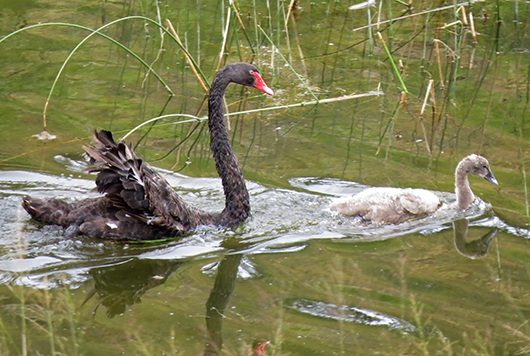
Our single Black Swan cygnet has grown rapidly and is now seven weeks old.

Azure Kingfishers from the verandah
Azure Kingfisher is still here daily. Two together on the same
creekside branch sometimes. My diaries record courtship displays
in previous Mays and Junes. It's surprising just how many species
are actively courting still. I'm beginning to suspect that some
of our fairy-wrens never stop - Superb and Red-backed Fairy-wren
males are still full-plumaged and chasing each other about, though
resident Variegated Fairy-wren males have gone into eclipse plumage.
July, 2015 - Powerful Owl and more

We dropped in on this Powerful Owl at his rainforest roost on the way home from the airport.
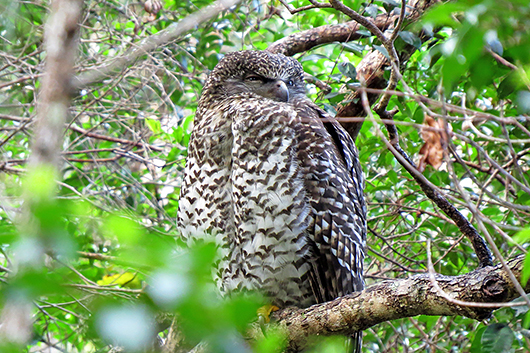
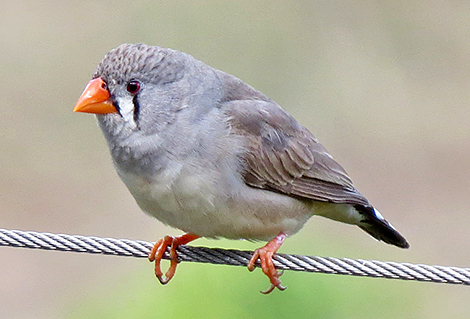
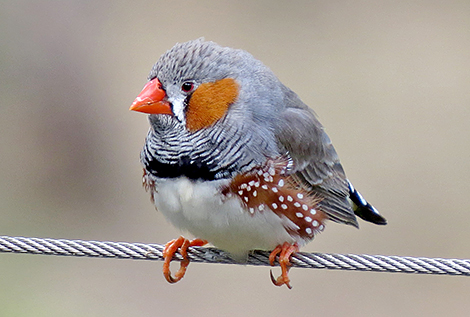
Zebra Finches on the verandah wires - female on the left, male to the right
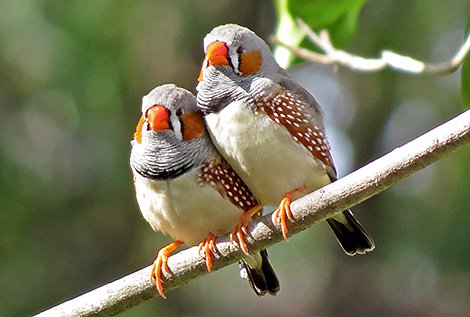
....and a couple of chaps hanging out together
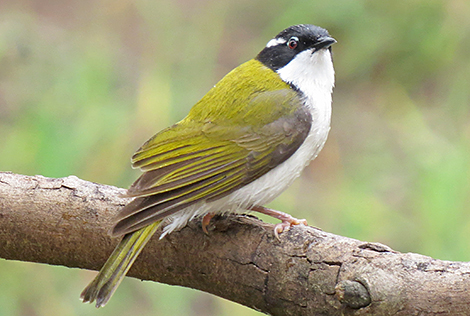
White-throated Honeyeater
September, 2015 - Thoroughly Spring, activity everywhere!
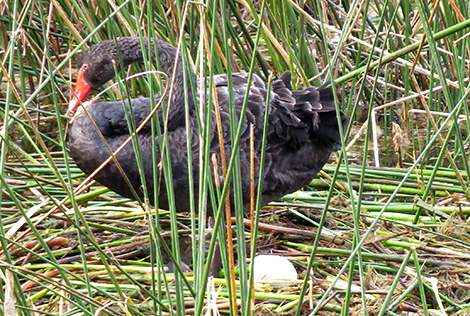
Black Swan at nest - again
Black Swans nested earlier this year. They layed their first egg at the end of February and hatched just one youngster on 10th April. We watched it grow to close to the size of the parents over a few months
before they all moved on somewhere else. Now the adult birds are back
and nesting again just a few metres from the nest they left only five
months ago! I wondered at first if it might be intended as a sort of day-bed
(Dusky Moorhens make a few of those), but no - there's already at least
one egg in it, and she's sitting tight every day.
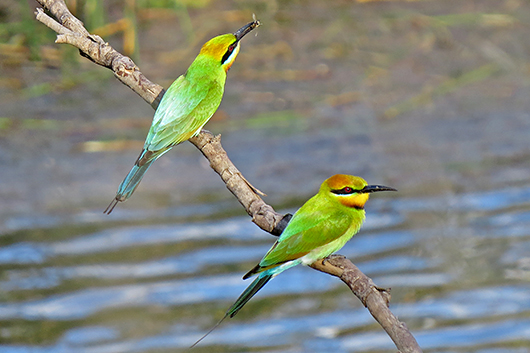
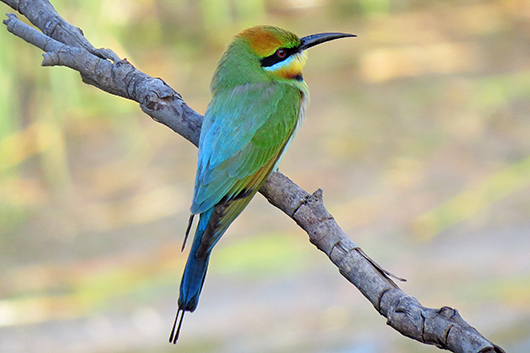


Rainbow Bee-eaters have been around all through the winter, but are now
clearly in pairs.
This pair spent an hour or more the other day hawking from the same creekside snag which
the Azure Kingfisher usually claims.
Leaden Flycatchers are paired up and displaying exuberantly, Olive-backed Orioles are nesting.
I've mentioned before that I can't
resist Speckled Warblers, so here's another pic taken from my desk. Expect
more - I just can't help it.
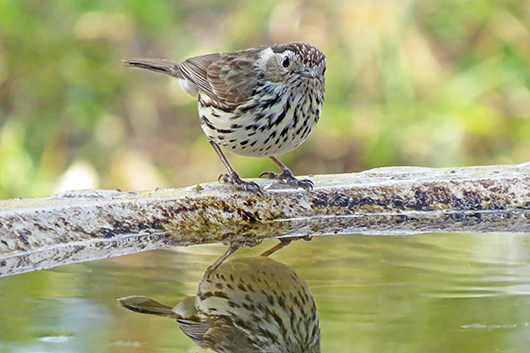
Speckled Warbler
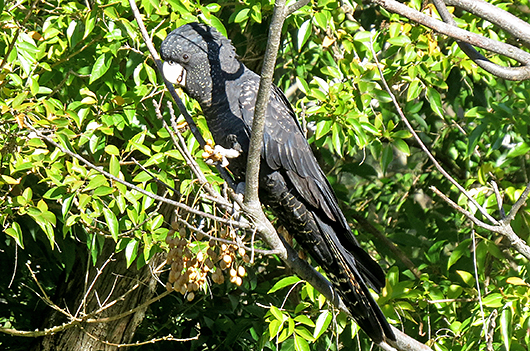
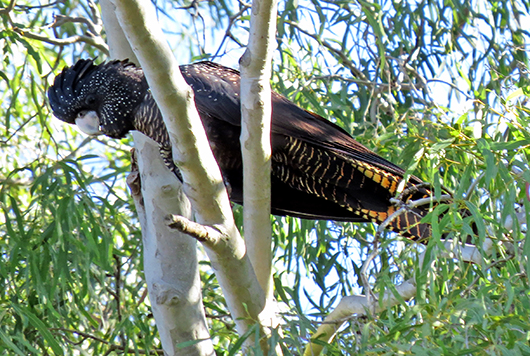
Red-tailed Black Cockatoo - females

Red-tailed Black Cockatoo - male
Still September - Non-stop Fairy-wrens
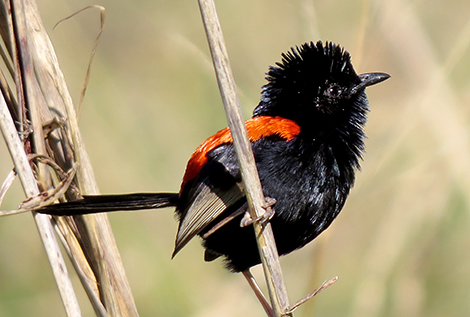
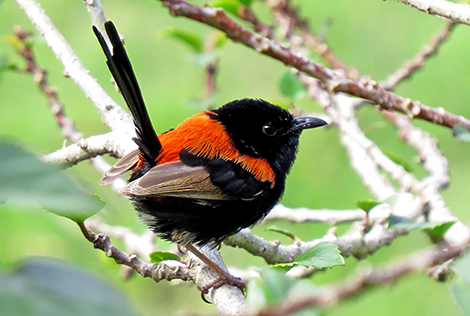
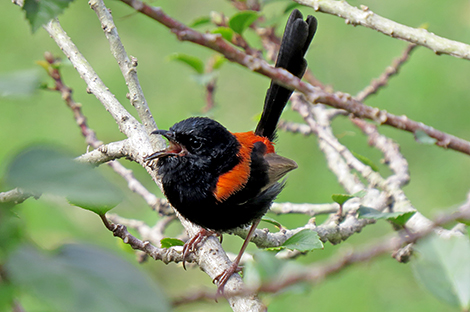
Red-backed Fairy-wrens
For our three local species of Fairy-wrens it seems to be non-stop courtship at
present. Just a whirlwind of singing, posing, chasing after and chasing
off, often overlapping between species - at any rate, appearing to overlap
to our slower eyes and ears. Their paths frequently cross in seemingly
complex ways, but I doubt they find it as confusing as we do.
All three species are here every day, Red-backed in the largest numbers - I'd guess
at least half a dozen families spread out over the property. Superb run
second in numbers, maybe half as many family units - and one or two families
of Variegated. These are conservative estimates. I know I've counted 20
plus individual Red-backed Fairy-wrens some days, but I wouldn't be surprised
if there are more than that at times.

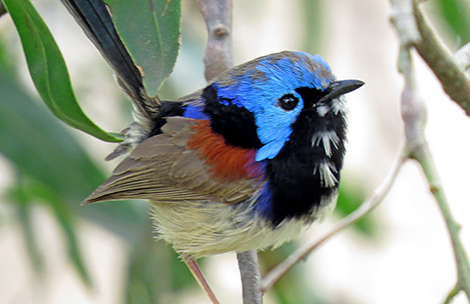


A Superb Fairy-wren
male bearing a yellow bouquet destined for his nearest lady friend, and
an off the cuff snap of a male Variegated Fairy-wren who appeared right
next to me, too close to photograph really. He is almost back in full
plumage after his non-breeding eclipse.
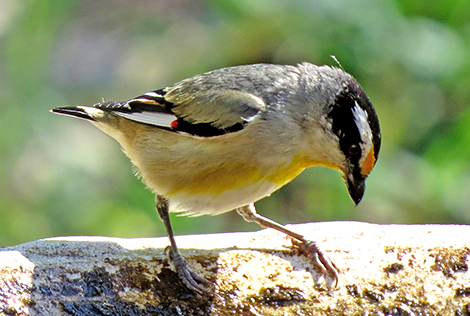
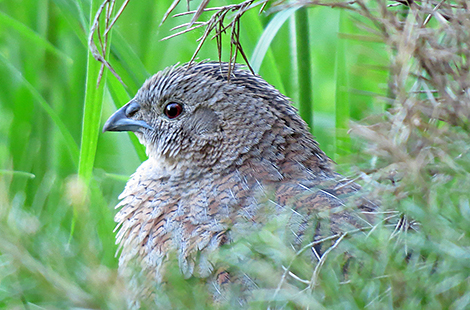


October, 2015 -
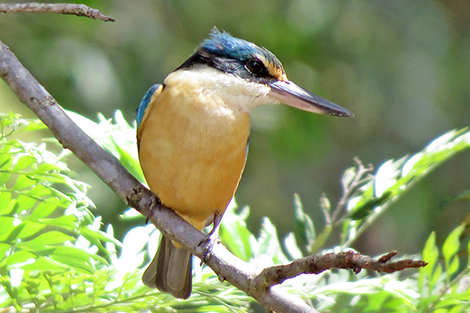



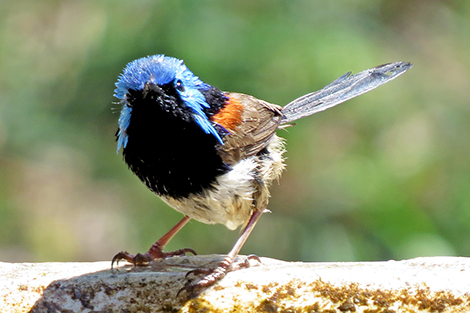
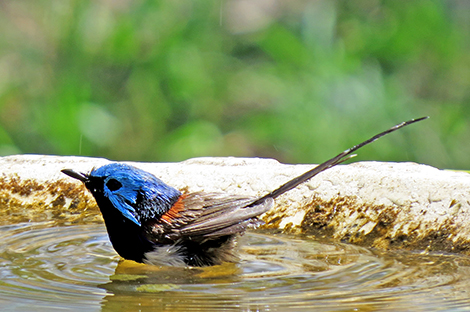
Variegated Fairy-wren
Just look at the long tail on this male Variegated Fairy-wren!
Our Black Swans did better second time round this year and have produced four healthy-looking cygnets.
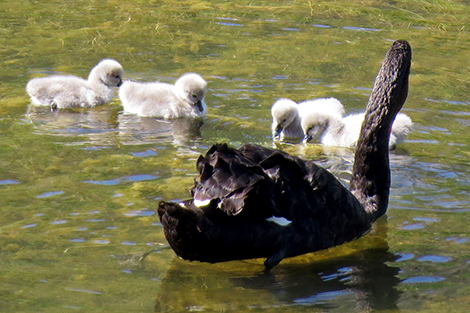

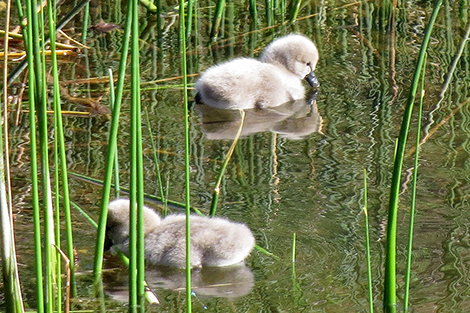
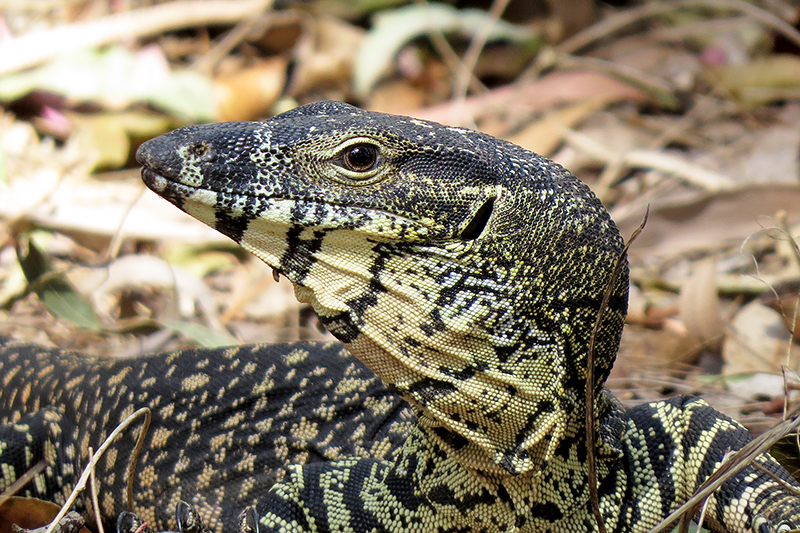
Lace Monitor
This is about as close a look as you'd probably care to get of a Lace Monitor. He's at the top of the food chain around here and a formidable predator, readily climbing trees to rob nests of eggs, chick, adults just about anything they come across! The Lace Monitor is the same genus (Varius) as the Komodo Dragon, but thankfully not as big - though a large male can be up to 2 metres long.
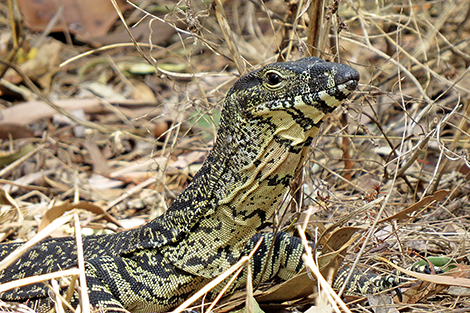
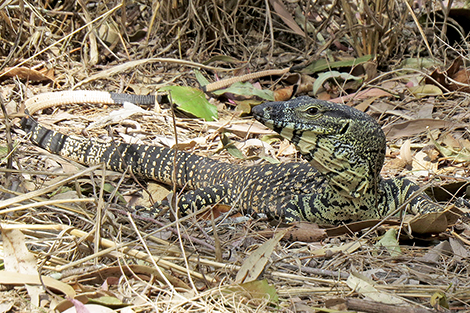
November, 2015 -
October routinely finds our resident Tawny Frogmouths sitting on eggs, faithful to the same tree fork every year.
And November usually reveals two big chicks staring down at us - but this year there appears to be only one.
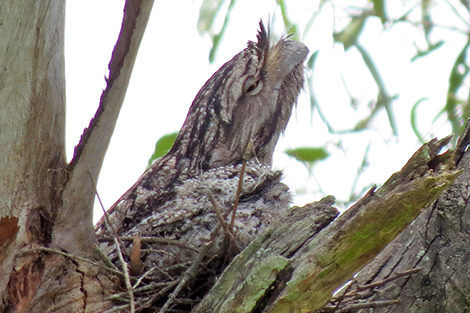
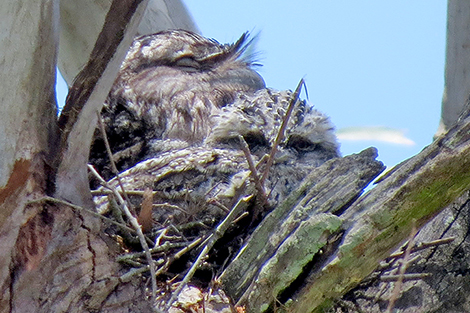

Black-necked Storks alongside a lake in the late afternoon.
Black-winged Stilts and Marsh Sandpipers are there too, as well as some background dots that are Sharp-tailed Sandpipers!
The Black Swans and their four cygnets left their nest only the day after hatching was complete, and headed off along the creek to who knows where - in contrast to their previous nesting here, when they stayed on and around the nest for a few weeks.
A week or so later, we were delighted to see the family approaching from some way along the creek, and heading directly for the vicinity of the nest, which in their absence had been appropriated as an occasional day bed by several Dusky Moorhens. But! There were only three cygnets. Of course, we became anxious and double and treble-checked as they came nearer and nearer. Oh dear, definitely only three.

However, with relief, we spotted a small white head appear from amongst the black feathers on the female parent's back. Only three of the youngsters were swimming - one was having a ride. The male swan sent the moorhen squatters scattering noisily, but having re-asserted their claim, the swans stayed for only a few hours before heading off again into the wider world.
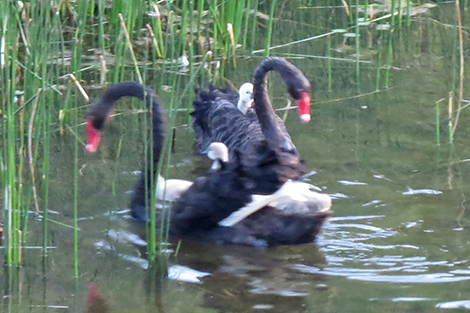
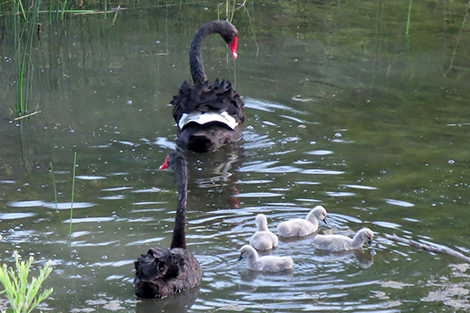
|
